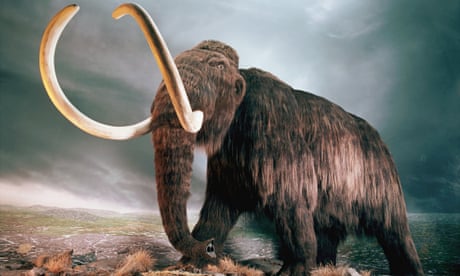Another team is seriously at it. That makes at least three. Time frames are at best optimistic, but there is a clear path forward and we also see a solid rational for all this.
It would allow the African elephant to be moved into the boreal forest and tundra as well. They do need trees knocked down there.
All good and added to other agricultural possibilities for the boreal forest we get an additional resource.
.
Woolly mammoth on verge of resurrection, scientists reveal
Scientist leading ‘de-extinction’ effort says Harvard team could create hybrid mammoth-elephant embryo in two years
Woolly mammoth (Mammuthus primigenius), a model of an extinct Ice Age mammoth. Photograph: Andrew Nelmerm/Getty Images/Dorling Kindersley 411
Hannah Devlin Science correspondent
Thursday 16 February 2017 15.00 GMT Last modified on Thursday 16 February 2017 18.20 GMT
The woolly mammoth vanished from the Earth 4,000 years ago, but now scientists say they are on the brink of resurrecting the ancient beast in a revised form, through an ambitious feat of genetic engineering.
Speaking ahead of the American Association for the Advancement of Science (AAAS) annual meeting in Boston this week, the scientist leading the “de-extinction” effort said the Harvard team is just two years away from creating a hybrid embryo, in which mammoth traits would be programmed into an Asian elephant.
“Our aim is to produce a hybrid elephant-mammoth embryo,” said Prof George Church. “Actually, it would be more like an elephant with a number of mammoth traits. We’re not there yet, but it could happen in a couple of years.”
The creature, sometimes referred to as a “mammophant”, would be partly elephant, but with features such as small ears, subcutaneous fat, long shaggy hair and cold-adapted blood. The mammoth genes for these traits are spliced into the elephant DNA using the powerful gene-editing tool, Crispr.

.
Could we 'de-extinctify' the woolly mammoth?
Read more Until now, the team have stopped at the cell stage, but are now moving towards creating embryos – although, they said that it would be many years before any serious attempt at producing a living creature.
“We’re working on ways to evaluate the impact of all these edits and basically trying to establish embryogenesis in the lab,” said Church.
\
Since starting the project in 2015 the researchers have increased the number of “edits” where mammoth DNA has been spliced into the elephant genome from 15 to 45.
“We already know about ones to do with small ears, subcutaneous fat, hair and blood, but there are others that seem to be positively selected,” he said.
Church said that these modifications could help preserve the Asian elephant, which is endangered, in an altered form. However, others have raised ethical concerns about the project.
Matthew Cobb, professor of zoology at the University of Manchester, said: “The proposed ‘de-extinction’ of mammoths raises a massive ethical issue – the mammoth was not simply a set of genes, it was a social animal, as is the modern Asian elephant. What will happen when the elephant-mammoth hybrid is born? How will it be greeted by elephants?”
Church also outlined plans to grow the hybrid animal within an artificial womb rather than recruit a female elephant as a surrogate mother - a plan which some believe will not be achievable within the next decade.
“We hope to do the entire procedure ex-vivo (outside a living body),” he said. “It would be unreasonable to put female reproduction at risk in an endangered species.”
He added that his lab is already capable of growing a mouse embryo in an artificial womb for 10 days - halfway through its gestation period.
“We’re testing the growth of mice ex-vivo. There are experiments in the literature from the 1980s but there hasn’t been much interest for a while,” he said. “Today we’ve got a whole new set of technology and we’re taking a fresh look at it.”
“Church’s team is proposing to rear the embryo in an ‘artificial womb’ which seems ambitious to say the least – the resultant animal would have been deprived of all the pre-birth interactions with its mother,” said Cobb.
The woolly mammoth roamed across Europe, Asia, Africa and North America during the last Ice Age and vanished about 4,000 years ago, probably due to a combination of climate change and hunting by humans.
\
Their closest living relative is the Asian, not the African, elephant.
Read more “De-extincting” the mammoth has become a realistic prospect because of revolutionary gene editing techniques that allow the precise selection and insertion of DNA from specimens frozen over millennia in Siberian ice.
Church helped develop the most widely used technique, known as Crispr/Cas9, that has transformed genetic engineering since it was first demonstrated in 2012. Derived from a defence system bacteria use to fend off viruses, it allows the “cut and paste” manipulation of strands of DNA with a precision not seen before.
Gene editing and its ethical implications is one of the key topics under discussion at the Boston conference.
Church, a guest speaker at the meeting, said the mammoth project had two goals: securing an alternative future for the endangered Asian elephant and helping to combat global warming. Woolly mammoths could help prevent tundra permafrost from melting and releasing huge amounts of greenhouse gas into the atmosphere.
“They keep the tundra from thawing by punching through snow and allowing cold air to come in,” said Church. “In the summer they knock down trees and help the grass grow.”
The scientists intend to engineer elephant skin cells to produce the embryo, or multiple embryos, using cloning techniques. Nuclei from the reprogrammed cells would be placed into elephant egg cells whose own genetic material has been removed. The eggs would then be artificially stimulated to develop into embryos.
Church predicts that age-reversal will become a reality within 10 years as a result of the new developments in genetic engineering.

No comments:
Post a Comment